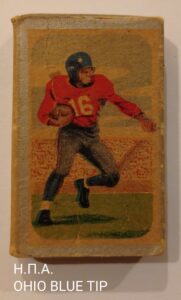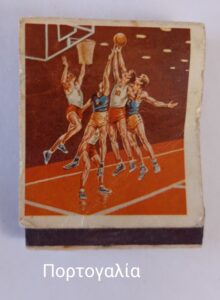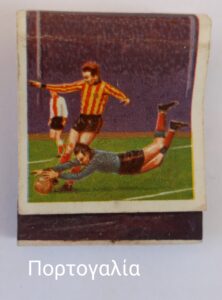
In many matchboxes of different countries there are depictions of athletes. Soccer players, basketball players, boxers, equestrian athletes, golfers and many other sports adorn the faces of matchboxes. It is not accidental. Sport is an attraction for many people. In fact, athletes very often become role models for society and especially young children want to look like them, following their path in sports.
T elevision broadcasts their efforts in sports organizations, while very often in the media news from their daily life, their interviews, their advertisements or even tributes to them are shown. Through such a promotion, it makes perfect sense for athletes to have a significant impact on society as a whole.
elevision broadcasts their efforts in sports organizations, while very often in the media news from their daily life, their interviews, their advertisements or even tributes to them are shown. Through such a promotion, it makes perfect sense for athletes to have a significant impact on society as a whole.
Usually -not always- the value of an athlete and his distinctions are the main parameter in terms of his impact on the world. A successful, talented and acclaimed athlete clearly influences more people than an unknown or mediocre athlete.
Athletes act as role models because their example shows that nothing is impossible and that effort and talent can go a long way…
It is certain that the most “influential” athletes earn a lot of money, advertise their sport and support the entire sports entertainment industry, that counts billions in revenue and profits.
The model athlete it is not enough to be a good athlete. There are many different parameters:
He must be a “proper” professional and “lover” of training,
He must have, of course, important distinctions that will make his compatriots proud, and if he had to overcome ” Symplegades” in his personal life in order to achieve them, this is even better,
He must bring out a “good person” in society,
He should not provoke with a rich life, even though his financial situation allows it
He must financially support the weak,
He must be serious in his personal life,
He must not live a “prodigal life” off the field,
He must be involved in politics and be able to speak adequately on burning social issues, without departing from the mood of public opinion,
and of course necessarily to handle “properly” social media, but also any means that has to do with its public promotion.
All of these, and perhaps more, are needed by a model athlete, but not all of them are necessary for being a good athlete.
 A top basketball player, Charles Barkley, had said of standard athletes: “I’m not a model, I’m not paid for it. Parents should be role models for their children, not me because I nail a ball!”
A top basketball player, Charles Barkley, had said of standard athletes: “I’m not a model, I’m not paid for it. Parents should be role models for their children, not me because I nail a ball!”
The most typical example of a great athlete who did not want to be a role model was the American basketball player, the “bad boy” of the NBA, Denis Rodman.
What Barkley and Rodman say is: “It’s not my problem that you think I should do the proper extraterrestrial life because I’m famous and you watch me live 100 times a year and you admire me for what I do on the floor. It is your problem if you want to raise me to a throne and make me the way you want me to be, I am something else”.
Maybe they wanted to shake off the stress and anxiety that is created by knowing that as public figures their daily life, their views, their actions come under the microscope! Nikos Galis, the great Greek basketball player who led the Greek national team to its greatest collective distinction, had said in one of his rare interviews that it was difficult to move on the road, even by car, because you can not even touch your nose”.
What is certain, however, is that at a time when the bank accounts of some athletes, few but famous, may -directly or indirectly- either inflate and overflow, or completely empty the sponsorships of large multinational companies, the limits of the athlete’s unconventionality are mostly determined by these companies themselves, by opening or closing the “cannula”. It is also known that the multinational companies in the sports industry, which are also sponsors of great athletes, have as “noble” purpose to maximize their profits and when they even claim that “nothing is impossible” they prove it by taking advantage of the children’s work in the poor countries of the third world!
athletes, few but famous, may -directly or indirectly- either inflate and overflow, or completely empty the sponsorships of large multinational companies, the limits of the athlete’s unconventionality are mostly determined by these companies themselves, by opening or closing the “cannula”. It is also known that the multinational companies in the sports industry, which are also sponsors of great athletes, have as “noble” purpose to maximize their profits and when they even claim that “nothing is impossible” they prove it by taking advantage of the children’s work in the poor countries of the third world!
However, athletes who, due to their achievements and distinctions, become famous and world renowned, whether they like it or not, are public figures and are an example for young people and not only, leaving their mark on society.
Recently, there has been a lot of talk about two athletes, Antetokounmpo and Tsitsipas, but not for their great athletic successes and the profits that are secured by them, which are huge -perhaps their only common elements- but for their personal attitude and the messages that are passed on to society.
 But one can not compare on the one hand the “glamor”, the statements of grief for the lack of luxury clothing stores, the participation in the campaign “We stay Safe” while we declare against the vaccination and on the other hand, the acts of solidarity, altruism and empathy . They express not only two different paradigms but two different worlds!
But one can not compare on the one hand the “glamor”, the statements of grief for the lack of luxury clothing stores, the participation in the campaign “We stay Safe” while we declare against the vaccination and on the other hand, the acts of solidarity, altruism and empathy . They express not only two different paradigms but two different worlds!
The conclusion comes out without much difficulty: “Hard work for the athlete to be a social model, he must be authentic and above all he mustn’t be big-headed , otherwise his image makers will not save him either!

